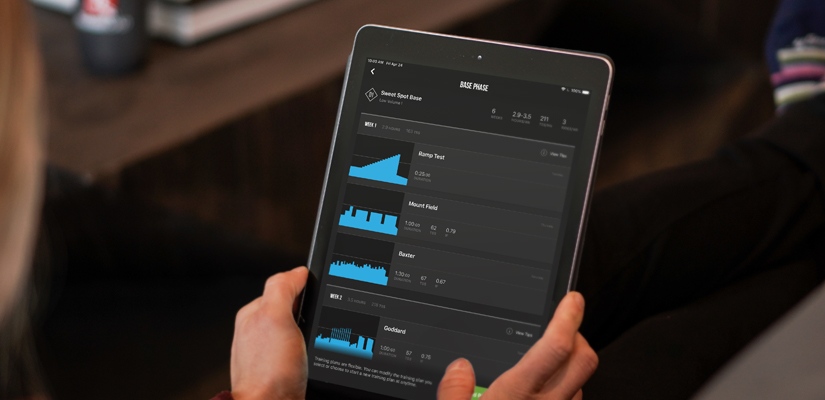Base Training: How to Decide Your Best Approach

Variables like your cycling experience level, schedule and type of event you’re training for determine the approach you should take to base training. Take a look at these three rider-type scenarios to help you decide which approach works best for you.
Triathlete
Experience: Moderate
Availability: Minimal time to train (6 hours/week on the bike)
Recommended base plan: Low-Volume Full Distance Triathlon Base plan
Rider A has a family and full-time job. Every hour this athlete has available to train s/he has to make the most of it. While travel time for swimming can lift weekly training time, a full-distance “finisher” — someone who’s not necessarily looking to set PR’s or reach the podium — can do so on as little as 12 hours/week, with 5-6 hours dedicated to the bike.
If you see yourself as Rider A, a moderately experienced triathlete who’s time crunched with less than 8 hours/week to train on the bike, TrainerRoad’s Low-Volume Full Distance Triathlon Base plan is likely your best option. These plans favor building a higher FTP instead of only logging long hours of low-end endurance. Follow your Base plan with TrainerRoad’s Low-Volume Build and Full-Distance Specialty plans and you’ll be on the right path to a successful race-day performance.
Enthusiast
Experience: Beginner
Availability: A lot of free time to train (13 hours/week)
Recommended base plan: Sweet Spot Base
Rider B has no real limits on the amount of time s/he can dedicate to training. While this situation is ideal, it often leads athletes into the “more is more” training philosophy. In turn, the chances of injury, illness and/or exhaustion increase.
Many new and less-experienced cyclists fail to recognize that the body responds most favorably to gradual, progressive amounts of stress. Sudden heaps of high-level intensity, lots of time in the saddle, or a combination of the two can over challenge these newcomers. At the same time, the challenge to their current ability has to be substantial enough to make an impact on their performance capabilities.
If you see yourself as Rider B, a beginner cyclist with upwards of 13 hours/week to train, consider starting on one of TrainerRoad’s Sweet Spot Base plans. With three to six interval workouts of week, these plans strike an important balance between doing too much and not doing enough. You’ll be pushed just hard enough to realize recognizable, safely acquired increases in fitness and technique. For a new cyclist, an additional increase in workload beyond what Sweet Spot Base plans outline is often unnecessary, counterproductive and can derail long-term improvement.
Road Racer
Experience: Seasoned rider
Availability: Moderate amount of time to train (8-10 hours/week)
Recommended base plan: Traditional Base or Sweet Spot Base. But across the board, Sweet Spot Base is recommended more often.
Rider C is a reasonably experienced athlete with around 8-10 hours/week to train. This type of rider can benefit from doing either the Traditional Base or Sweet Spot Base. To decide, it’s mostly a question of duration over intensity. Consider the pros and cons of each approach:
Traditional Base applies high doses of low intensity to help Grand Tour athletes or those recovering from an injury who want to avoid high-intensity intervals. This approach can be useful to these types of serious riders — but only if you have a lot of time.
Traditional Base requires the sort of rider who can tolerate long, mind-numbing hours of steadily turning the pedals in pursuit of slowly earned, incremental aerobic fitness gains. It’s no surprise a mindset that accepts monotonous workouts and training doldrums well is required.
The type of gains you can achieve through Traditional Base are useful to a limited number of athletes, such as Grand Tour riders and RAAM participants. These types of riders know that with this approach to training gains come slowly — if they come at all — since they depend on devoting a lot of time to riding easily.
Many long, slow and steady training adaptations use a blend of mildly and substantially higher intensity. Enter Sweet Spot Base and its mix of strength-endurance and max-aerobic training.
In contrast to Traditional Base, Sweet Spot Base is more all-inclusive and can get you more evenly fit for events in relatively less time. The workouts are substantially more varied, interesting, challenging in numerous ways and are comparatively entertaining. Just two or three of these workouts each week can bring measurable, inspiring fitness gains for all types of riders with varied training time limitations. Higher-volume riders who are able to train more frequently (4-6 times per week), can add in just enough of the long, slow, traditional riding to further their gains a little, or to simply spend more time riding for weight loss or maintenance.
Opposite of Traditional Base workouts, Sweet Spot Base workouts require focus, concentration and often enough, a willingness to endure more intense — but shorter — durations of riding discomfort.
If you commit to Sweet Spot or Traditional Base, you will have desirable training outcomes. However, we recommend Sweet Spot Base for 99% of cyclists.
Key Takeaway
Traditional Base assumes you have almost unlimited time to ride at a slow pace. Whereas Sweet Spot Base assumes you have a limited schedule like most non-professional cyclists, which allows you to compensate for the lack of duration with an increase in intensity. That being said, time is not the only factor when deciding on your base training plan. You must also consider your experience, the type of rider you are and the cycling event you’re preparing for.
Action Item
First, look at your winter schedule and decide on a realistic number of training hours you can commit to each week. Next, evaluate your most important events for the year and ask whether or not you’d like to get fit quicker for your lower-priority events. Finally, take into account your training history/experience, tolerance for patience and overall interest in working out. Once you’ve considered all these things, you’ll be positioned to make a decision on the direction to take with your base training.
This is one section of my Winter Training Guide. Read the full guide here to discover 11 coaching tips to help you become a faster cyclist right now.

